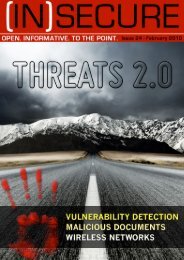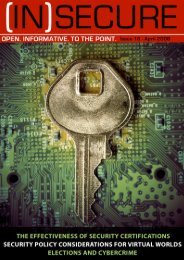download issue 27 here - Help Net Security
download issue 27 here - Help Net Security
download issue 27 here - Help Net Security
You also want an ePaper? Increase the reach of your titles
YUMPU automatically turns print PDFs into web optimized ePapers that Google loves.
II. Data flows and systems<br />
Create a data flow diagram that documents<br />
w<strong>here</strong> payment card numbers are stored,<br />
processed and transmitted. From the PCI<br />
Data <strong>Security</strong> Standard, diagrams should detail<br />
physical and logical data flows, “including<br />
transmission and processing of card data,<br />
authorization, capture, settlement, chargeback<br />
and other flows as applicable” (bit.ly/b7di9). As<br />
a best practice, scan for payment card data<br />
outside the PCI environment at least annually.<br />
Next, establish an inventory to document the<br />
systems, applications and databases associated<br />
with each PCI environment. Include details<br />
such as information owner, data custodians,<br />
application managers, PCI network scans<br />
and when the last application assessment was<br />
conducted.<br />
Card Brand Comments Regular Expression<br />
Visa All Visa card numbers start with a 4. ^4[0-9]{12}(?:[0-9]{3})?$<br />
MasterCard All MasterCard card numbers start with numbers 51<br />
through 55.<br />
^5[1-5][0-9]{14}$<br />
American Express American Express card numbers start with a 34 or 37. ^3[47][0-9]{13}$<br />
Discover Discover card numbers start with 6011 or 65. ^6(?:011|5[0-9]{2})[0-9]{12}$<br />
III. Risk and control assessments<br />
PCI requirement 12.1.2 includes an annual<br />
process that identifies threats, and vulnerabilities,<br />
and results in a formal risk assessment.<br />
To identify threats and vulnerabilities, subscribe<br />
to US CERT advisories, the DHS daily<br />
cyber report and vendor security alerts. Merchants<br />
can obtain the Visa list of vulnerable<br />
applications from their acquiring bank. Information<br />
security professionals should join the<br />
U.S. Secret Service Electronic Crimes Task<br />
Force and FBI InfraGard. ECTF and InfraGard<br />
are free and provide threat and vulnerability<br />
advisories.<br />
The scope of a PCI risk assessment is the<br />
same as that of a PCI assessment. Follow the<br />
flow of payment card data in production and<br />
disaster recovery environments and evaluate<br />
compensating controls. Conduct a thorough<br />
risk assessment before implementing new<br />
technologies such as virtualization or cloud<br />
computing.<br />
Conceptualize data flow as a pipe with holes<br />
in it. Areas of vulnerability include systems between<br />
encrypted network connections and the<br />
System<br />
Component<br />
Potential<br />
Failure Mode<br />
Potential<br />
Effect(s) of<br />
Failure<br />
Source: PCI <strong>Security</strong> Standards Council.<br />
Severity<br />
Potential<br />
Cause(s) of<br />
Failure<br />
data flow channel itself such as application<br />
security attacks that easily pass infrastructure<br />
security controls.<br />
IV. Failure Mode and Effects Analysis<br />
Failure Mode and Effects Analysis (FMEA) is a<br />
method used to evaluate potential failures<br />
within a process or system. Analysis includes<br />
consideration of failure severity, rate of occurrence<br />
and detection. FMEA was introduced in<br />
the 1940s by the US Armed Forces. Later, it<br />
was adopted by NASA, the Ford Motor Company<br />
and most recently, Six Sigma<br />
(bit.ly/KZvHY).<br />
FMEA is also a practical way to conduct a<br />
technical risk assessment (bit.ly/cD80M2).<br />
Depending on the size and complexity of the<br />
environment, it will take between eight and<br />
sixteen hours to conduct an FMEA evaluation.<br />
In large organizations, maintenance of controls<br />
may be assigned to several teams.<br />
FMEA participants should include representatives<br />
from physical security, system and network<br />
administration, application development,<br />
information security and operations.<br />
Occurrence<br />
Current<br />
Process<br />
Controls<br />
Detection<br />
www.insecuremag.com 45<br />
RPN





